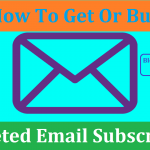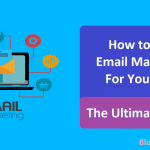We receive emails daily.
For some of us, we get at least 10 emails in our inboxes daily, and most of the messages in our inbox are a barrage of automated email newsletters send by autoresponders because we visited a certain blog, website, or e-commerce site and agreed to give out our email addresses to receive a newsletter.
Maybe we were promised a free email course, and because the first few links sent our ways were great we never unsubscribed.
And for most of us, there are newsletters we earnestly wait for weekly because they are so good. Of course, there are newsletters we unsubscribed from soon after we received the first follow-up email.
So, what if the tables are turned? Would your newsletters be the kind that your subscribers look forward to? How will you ensure that your email marketing campaigns are successful?
The truth is that email marketing campaigns are effective in reaching all age groups and this strategy is up to 40 times more successful in customer acquisition and retention compared to Facebook and Twitter combined.
Email promises more traffic to your website and blog, and it brings in more qualified leads. But, do you have what it takes to reap these benefits?
Personalization, use of imagery, appropriate CTAs, and a responsive design make effective campaigns in email marketing, but how do you measure the success rates of the campaigns against each other, then pick the one that works best?
Well, we have an answer – running A/B tests. The tests will guide your email marketing strategy increasing the open rates for emails, as well as sales.
It is pertinent to run A/B tests when trying out new email marketing campaigns. The results of the test will improve your conversion rates and increase your ROI.
Contents In Page
Your Comprehensive Guide to A/B Testing
A/B testing refers to the process of figuring out the best online marketing and promotional strategies for your business or blog.
The idea is to send one version of your email campaign to one subset of your email subscribers and the other version to the other subset.
The goal is to pick the campaign that garners the best results.
The tests can be as simple as sending multiple subjects one campaign to check open or advanced where you test different templates against each other to determine the one that gets the highest click-through rate.
In email marketing, there are steps you should follow. They include:
Deciding the elements of the campaign you want to test
You might have to test every aspect of your email marketing strategy, but for the accuracy of your results, you should consider testing one element of your campaign, one after the other.
You could test the email subject line, your Call-to-Action, the testimonials to include, the message’s structure you are sending, as well as personalization.
The tests could be as simple as determining whether addressing your subscriber as Mr. Phil is better than Phil, and vice versa.
The email body text, closing texts, headline, image, or the details of the offer might be tested as well.
Tests on these elements will most likely affect parts of your email marketing conversion process, hence their significance. An example is the Call-to-Action which will affect the click through rates for the landing page. The subject line affects the number of people who will open the email.
Since these elements have a significant effect on the campaign’s conversion rate, you should test them first.
The other things that you should consider testing include the length of the email subject line, subject line word order, and content, among others.
Testing Whole Lists Vs. Partial Sections of the List
While you wish to get every detail of your email list, it is not always necessary or financially feasible to test every bit of that list.
For example, if tests are based on the number of email addresses, you might have to test only the biggest sample that your budget can meet. If trying an extreme campaign strategy, limit exposure by making sure that the least possible number of subscribers see it. Also, for limited time offers, you run the offer on a small batch first.
Keep in mind that when it comes to lists, your results are more accurate when you have a large test sample.
If you want to skew the A/B test results, handpick your email recipients. Keep in mind that you are only collecting empirical data which you can use to determine the best version of that test material.
What is success to you?
By looking at your past results, especially if your campaign style hasn’t changed in months, you will get a general idea of the data pool to pull information from.
A look at your past result will determine if the recent test is a success or not.
Again, your definition of success will depend on the amount of improvement you are looking for and whether or not you are looking for an improvement.
Choosing the right tools for testing
There are several tools for testing email campaign success. These tools are present in top email campaign software like MailChimp and Campaign Monitor.
Note that some software lack the A/B testing tools and you will have to set up an A/B test manually.
For manual testing, split your list to two and send out version A of your campaign to list A and version B of the campaign to list B. Comparing the results from the two tests is as simple as exporting the results to an Excel file.
Analyzing Results
After running tests, you have to check the results. Things to analyze include the open-rate, the conversion rate, and the click-through rate.
For the success of you’re a/B Tests, do the following three things:
Have a hypothesis about why a particular version of your email marketing campaign will perform better than the other.
Set your priorities right
Between the copy changes, button colors and subject lines, it is easy to get confused about the test you intend to run. So, you need to look at your tests in terms of the impact it will have, your confidence in the success of that element, and the ease of implementing the test.
Learn from the knowledge learned
When running A/B tests, you should know that your results might have negative conversions and in other cases, you might not have any conversions. So, be ready to accept the outcome and then build on those results.
Conclusion:
Running A/B tests is important because it gives you a place to base your marketing campaigns on – in this case, data.
Also, whether the tests work or not, they are based on actual responses from your customers, and you will get to create and run effective campaigns based on the insights gained from the tests. Lastly, it lowers the risk of running a new campaign before you make permanent changes.
Finally, know that to run a successful campaign and an A/B test, you should know your audience and segment your email list.








